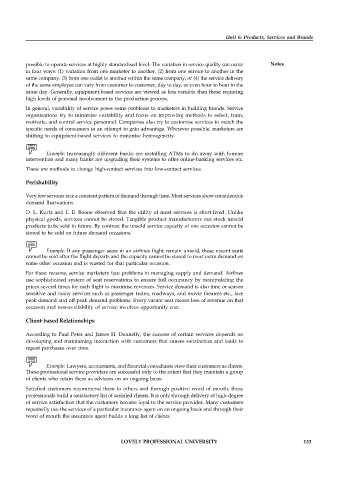Page 140 - DMGT408DMGT203_Marketing Management
P. 140
Unit 6: Products, Services and Brands
possible to operate services at highly standardised level. The variation in service quality can occur Notes
in four ways: (1) variation from one marketer to another, (2) from one service to another in the
same company, (3) from one outlet to another within the same company, or (4) the service delivery
of the same employee can vary from customer to customer, day to day, or even hour to hour in the
same day. Generally, equipment-based services are viewed as less variable than those requiring
high levels of personal involvement in the production process.
In general, variability of service poses some problems to marketers in building brands. Service
organisations try to minimise variability and focus on improving methods to select, train,
motivate, and control service personnel. Companies also try to customise services to match the
specific needs of consumers in an attempt to gain advantage. Wherever possible, marketers are
shifting to equipment-based services to minimise heterogeneity.
Example: Increasingly different banks are installing ATMs to do away with human
intervention and many banks are upgrading their systems to offer online-banking services etc.
These are methods to change high-contact services into low-contact services.
Perishability
Very few services face a constant pattern of demand through time. Most services show considerable
demand fluctuations.
D. L. Kurtz and L. E. Boone observed that the utility of most services is short-lived. Unlike
physical goods, services cannot be stored. Tangible product manufacturers can stock unsold
products to be sold in future. By contrast the unsold service capacity of one occasion cannot be
stored to be sold on future demand occasions.
Example: If any passenger seats in an airlines flight remain unsold, these vacant seats
cannot be sold after the flight departs and the capacity cannot be stored to meet extra demand on
some other occasion and is wasted for that particular occasion.
For these reasons, service marketers face problems in managing supply and demand. Airlines
use sophisticated system of seat reservations to ensure full occupancy by manipulating the
prices several times for each flight to maximise revenues. Service demand is also time or season
sensitive and many services such as passenger trains, roadways, and movie theatres etc., face
peak-demand and off-peak demand problems. Every vacant seat means loss of revenue on that
occasion and non-availability of service involves opportunity cost.
Client-based Relationships
According to Paul Peter and James H. Donnelly, the success of certain services depends on
developing and maintaining interaction with customers that causes satisfaction and leads to
repeat purchases over time.
Example: Lawyers, accountants, and financial consultants view their customers as clients.
These professional service providers are successful only to the extent that they maintain a group
of clients who retain them as advisors on an ongoing basis.
Satisfied customers recommend them to others and through positive word of mouth, these
professionals build a satisfactory list of satisfied clients. It is only through delivery of high-degree
of service satisfaction that the customers become loyal to the service provider. Many customers
repeatedly use the services of a particular insurance agent on an ongoing basis and through their
word of mouth the insurance agent builds a long list of clients.
LOVELY PROFESSIONAL UNIVERSITY 133

